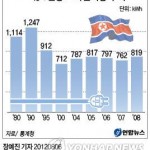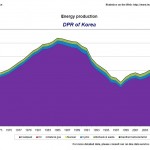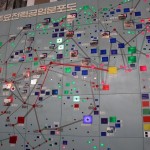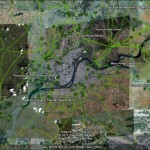Pictured above: (L-Yonhap) Estimated energy consumption in the DPRK; (R) IEA graph of DPRK energy production
Statistics Korea published information on DPRK energy consumption originally published by the International Energy Agency. I have added a link to the IEA’s DPRK data on my DPRK Economic Statistics Page.
The original data is behind a firewall (as best I can tell), so here is coverage of the report in the Daily NK:
Based on International Energy Agency (IEA) documentation, the statistics, which were made public on the 6th via Statistics Korea’s ‘North Korea Statistics Portal’, reveal that per capita electricity consumption in 2008 remained just 819kWh, substantially lower than the 919kWh recorded in 1971.
The figures are just the latest symbolic indicator of the protracted economic decline that began in the 1990s, when the national economy collapsed following the fall of the Soviet Union and the sudden demand that the majority of fuel imports be paid for in hard currency.
Rooted in the provision of low cost fuel by its larger communist neighbors, North Korean electricity consumption had risen steadily until 1991. By 1980 it had reached 1114kWh per capita, a figure that rose again over the next decade to reach 1247kWh by 1990. However, by 1995 it had declined precipitously to 912kWh, and at its nadir in 2000 per capita usage figure was just 712kWh.
This decline was subsequently arrested; however, the following seven years (including 2004 (787kWh), 2005 (817kWh), 2006 (797kWh) and 2007 (762kWh)) reflected how the country was (and remains) unable to recover to the 1990 standard, with population growth outstripping improvements in electricity generation.
In 1971, North Korea had a population of just 14.6 million, but by 2008 this was estimated to have risen to 23.9 million.
Here is coverage in Yonhap.
Read the full story here:
Economic Collapse Reflected in Scarce Electricity
Daily NK
Kim Tae Hong
2012-8-6




